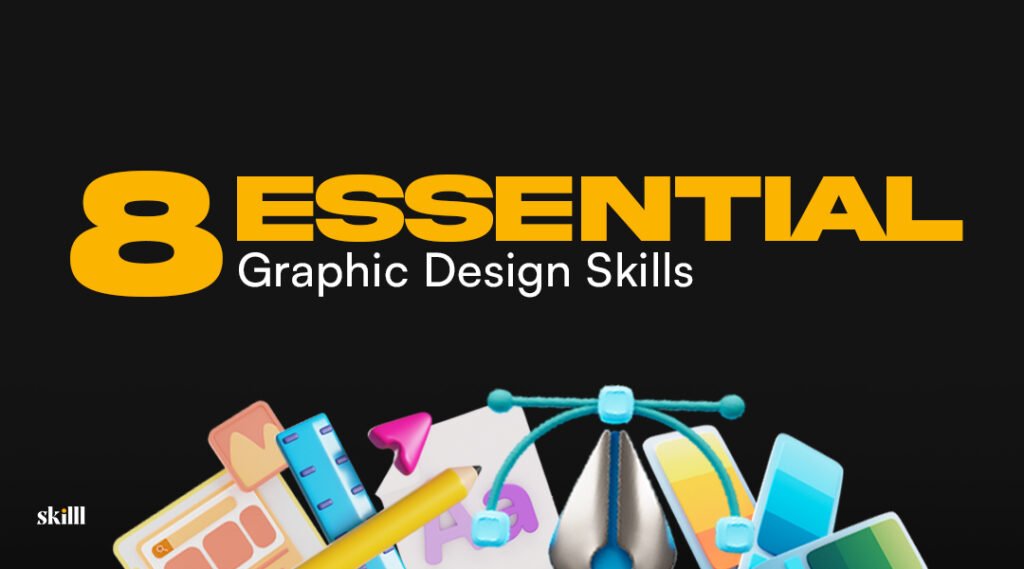The art of graphic design is the combination of technology and art to create visuals that engage audiences and deliver ideas. There are several skills all graphic designer has to know, whether they’re just getting started or want to improve their skills. We’ll look at 8 essential graphic design skills in this post that will help you succeed in the graphic design industry.
1. Creativity

Creativity lies at the core of graphic design. It’s the magic that transforms ordinary concepts into amazing visual experiences. Thinking creatively and approaching your task from a different angle are essential elements of creativity. When creating a logo, website, or advertisement, your unique style will make a lasting impression. Take inspiration from your surroundings, try out various looks, and never be scared to push the limits of what’s possible. To master this and other crucial abilities, explore the 8 essential graphic design skills that every designer should have.
2. Typography

The art of typography includes arranging text in a way that makes written language understandable, clear, and visually attractive. Selecting a font is not as important as understanding the functionality of type and how to use it to express ideas. Knowing font families, fonts, spacing, alignment, and structure are all essential to become proficient in typography. While poor-quality typography can make a design hard to read and understand, well-designed typography can improve it. You can see how strong typography can be in your designs if you pay attention to the little things. Mastering typography is one of the 8 essential graphic design skills every designer should aim to perfect.
3. Software Proficiency

In today’s digital world, being proficient in graphic design software is non-negotiable. The most commonly used tools include Adobe Photoshop, Illustrator, and InDesign, among others. Each software has its strengths and specific uses. For instance, Photoshop is great for image editing and photo manipulation, Illustrator is perfect for vector graphics and logos, and InDesign is ideal for layout design and publishing. Familiarize yourself with these tools, practice regularly, and stay updated with the latest features and trends.
4. UX/UI Design

User Experience (UX) and User Interface (UI) design are crucial aspects of graphic design, especially in the digital world. UX design focuses on the overall experience of the user when interacting with a product, while UI design deals with the look and feel of the product interface. Understanding the principles of UX/UI design will help you create designs that are not only beautiful but also functional and user-friendly. Consider the user journey, imagine their requirements, and produce user-friendly designs that improve their experience.
5. Communication

Graphic design is all about communication. Your designs need to communicate a message clearly and effectively. This requires strong communication skills, both visually and verbally. You need to understand the client’s needs, express your ideas, and clearly explain your design choices. Listening is equally important as it allows you to understand feedback and make necessary adjustments. Remember, great design is a collaboration between the designer and the client, and clear communication is key to successful outcomes. Developing these skills is part of mastering the 8 essential graphic design skills needed for success.
6. Color Theory

Color theory is the science and art of using color. It’s a fundamental aspect of design that can influence the mood, perception, and behavior of the viewer. Understanding color theory involves knowing about the color wheel, color harmony, and the psychological effects of colors. Different colors evoke different emotions and reactions, and choosing the right colors can significantly impact the effectiveness of your design. Experiment with color combinations, understand the cultural context, and use colors to create visually compelling designs.
7. Layout Skills

Layout skills are essential for organizing visual elements in a way that guides the viewer’s eye and enhances the overall design. A good layout creates a visual hierarchy, making it easy for the viewer to navigate through the information. It involves understanding principles like balance, alignment, proximity, and contrast. Whether you’re designing a website, a brochure, or a poster, a well-thought-out layout will make your design more appealing and effective. Practice creating different layouts, and pay attention to how elements interact with each other.
8. Attention to Detail

In graphic design, attention to detail can make the difference between a good design and a great one. It requires providing close attention to detail and making sure that each component of your design is perfect. This includes checking for alignment, spacing, color consistency, and typography. Small details, such as the placement of a logo or the spacing between lines of text, can have a big impact on the overall quality of your design. Develop a keen eye for detail, proofread your work, and always strive for perfection.
Conclusion
Mastering these 8 essential graphic design skills will set you on the path to success in the world of design. Creativity will keep your work fresh and innovative, while typography and color theory will enhance your visual communication. Software proficiency and UX/UI design will ensure you create functional and user-friendly designs. Communication skills will help you collaborate effectively, and layout skills and attention to detail will refine your work to perfection. To completely develop these skills and learn more, visit our website. Keep practicing, stay curious, and never stop learning.
